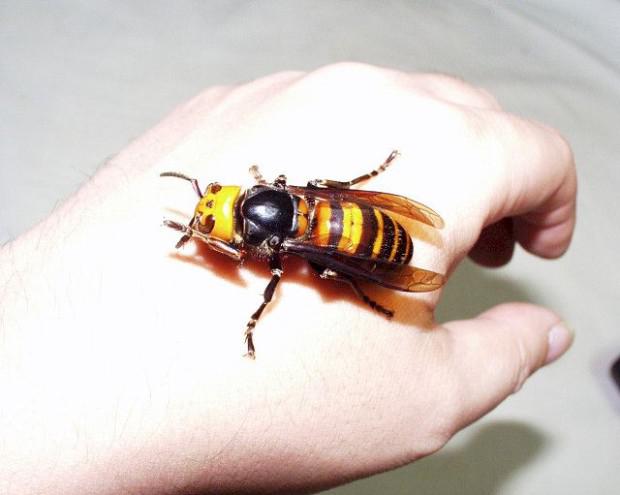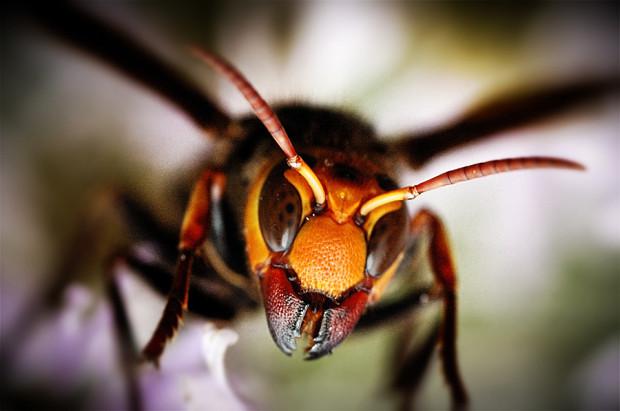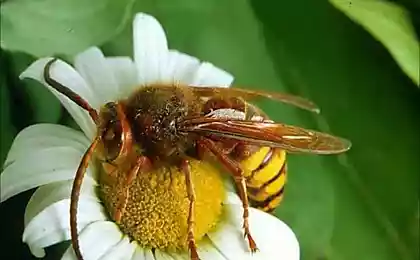1124
In Japan, home to the giant hornets, whose venom is capable of dissolving you
Sting like a glowing gvozd
I'm sure you have at least once in a lifetime bee bite. Bites honey bees, of course, it is quite sensitive, but the pain usually passes quickly, leaving only a slight itching. However, in Japan at the bees have "distant cousin" of the order Hymenoptera - Japanese huge hornet (Vespa mandarina japonica), an attack which may be much more dangerous to humans.
Sudzumebati (the Japanese name for the insect) are found only on the slopes covered with forests and reach 5 cm in length, with about 6 mm in body length accounts for the sting, and the scope of membranous wings an average of about 7, 5 cm.
But the size - not the most important weapon hornet: insect produces a highly toxic nerve poison that is able to literally dissolve the tissue of the human body and cause anaphylactic shock. At a sting hornet man hospitalized as soon as possible, but, nevertheless, from the attacks of the "winged Samurai" killed about 40 people a year.

One of the victims hornets compares the thrill of the bite with red-hot nail, which plunged deep into the body. Fortunately, these insects are not too aggressive and attack humans only when a clear threat, but the victim can pursue at a distance of five kilometers.
Hornets love to feast on honey, ruining beehives - one individual is able to kill 40 bees per minute, and the "force" of 30 sudzumebati can kill up to 30 thousand bees in three hours. Bees in the process of evolution learned to stop an attack of giant aggressors, using their numerical advantage of about 500 bees conclude hornet in a tight ball, and enhanced work muscles raise the temperature inside to 47 ° C, Hornet, which kills by heat shock, and for the defense of the hive so hot secure - they can withstand 50 ° C.
via factroom.ru

I'm sure you have at least once in a lifetime bee bite. Bites honey bees, of course, it is quite sensitive, but the pain usually passes quickly, leaving only a slight itching. However, in Japan at the bees have "distant cousin" of the order Hymenoptera - Japanese huge hornet (Vespa mandarina japonica), an attack which may be much more dangerous to humans.
Sudzumebati (the Japanese name for the insect) are found only on the slopes covered with forests and reach 5 cm in length, with about 6 mm in body length accounts for the sting, and the scope of membranous wings an average of about 7, 5 cm.
But the size - not the most important weapon hornet: insect produces a highly toxic nerve poison that is able to literally dissolve the tissue of the human body and cause anaphylactic shock. At a sting hornet man hospitalized as soon as possible, but, nevertheless, from the attacks of the "winged Samurai" killed about 40 people a year.

One of the victims hornets compares the thrill of the bite with red-hot nail, which plunged deep into the body. Fortunately, these insects are not too aggressive and attack humans only when a clear threat, but the victim can pursue at a distance of five kilometers.
Hornets love to feast on honey, ruining beehives - one individual is able to kill 40 bees per minute, and the "force" of 30 sudzumebati can kill up to 30 thousand bees in three hours. Bees in the process of evolution learned to stop an attack of giant aggressors, using their numerical advantage of about 500 bees conclude hornet in a tight ball, and enhanced work muscles raise the temperature inside to 47 ° C, Hornet, which kills by heat shock, and for the defense of the hive so hot secure - they can withstand 50 ° C.
via factroom.ru
From the viewpoint of the brain is similar to the pain of rejection
By law, all government cars in Cuba are obliged to bring up hitchhikers























